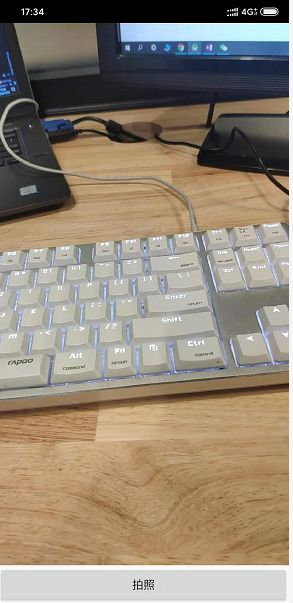前言
本次自定义相机使用的框架是CameraView,由CameraKitView衍生而来,以下为官方文档连接
https://natario1.github.io/CameraView/
心得:
1.早点转到AndroidX,现在android studio3.5(或者更早),新建项目时会强制使用androidx 本文由于要在公司的老项目中使用自定义相机,所以不能用CameraView2.3.1最新版(迁移到了androidx),而是用的1.6.1
由于官方文档一直对应的最新版,所以对于老版本和文档有出入的地方,请参考:
https://natario1.github.io/CameraView/extra/v1-migration-guide.html
2.android遇到问题别再百度了,国内各家都是互相抄过来抄过去,稍微好些,android遇到问题可以在stackoverflow上搜索
https://stackoverflow.com/search
3.拍照后得到的bitmap需要压缩后写入sd卡
压缩方式:
https://www.cnblogs.com/shoneworn/p/6932638.html
正式开始
一.导入框架&权限
//这里用的是没有迁移到androidx之前的老版本 最新版为2.3.1
implementation 'com.otaliastudios:cameraview:1.6.1'
二.Activity中基本使用
2.1 Activity布局
布局非常简单,就是一个CameraView和一个Button作为快门
2.2实现相机拍照功能 备注写的很清楚 不多赘述了
CameraActivity.class
public class CameraActivity extends AppCompatActivity {
//CameraView对象
private CameraView camera;
//shutter快门按钮
private Button shutter;
//保存图片的文件夹地址
String dirpath = Environment.getExternalStorageDirectory().getAbsolutePath() + File.separator + "formbackup";
@Override
protected void onCreate(Bundle savedInstanceState) {
super.onCreate(savedInstanceState);
setContentView(R.layout.activity_camera);
//实例化对象
camera = findViewById(R.id.camera);
shutter = findViewById(R.id.shutter);
//设置快门的监听
shutter.setOnClickListener(view -> takephoto());
camera.start();
initCamera();
}
//拍照的方法
private void takephoto() {
//调用capturePicture()进行拍照
camera.capturePicture();
//camera.takePicture(); //2.3.1修改的拍照方法
}
private void initCamera() {
//初始化相机 设置相机拍照后的处理
camera.addCameraListener(new CameraListener() {
@Override
public void onPictureTaken(byte[] jpeg) {
super.onPictureTaken(jpeg);
//通过jpeg获取图片的旋转角度orientation jpeg中包含了照片角度信息
int orientation = Exif.getOrientation(jpeg);
//通过jpeg获取bitmap对象
Bitmap bitmap = BitmapFactory.decodeByteArray(jpeg, 0, jpeg.length);
//将bitmap按解析出来的角度进行旋转orientation
//有些机型会将照片旋转90度
Matrix m = new Matrix();
m.postRotate(orientation);
bitmap = Bitmap.createBitmap(bitmap, 0, 0, bitmap.getWidth(), bitmap.getHeight(), m, true);
//进行拍摄成功后的处理
takeSuccess(bitmap);
}
});
}
public void takeSuccess(Bitmap bitmap) {//拍照成功后进行保存
//创建文件,要保存png,这里后缀就是png,要保存jpg,后缀就用jpg
//以拍摄时间为图片名进行命名
File file = new File(dirpath, System.currentTimeMillis() + ".jpg");
try {
//文件输出流
FileOutputStream fileOutputStream = new FileOutputStream(file);
//压缩图片,如果要保存png,就用Bitmap.CompressFormat.PNG,要保存jpg就用Bitmap.CompressFormat.JPEG,质量是100%,表示不压缩
bitmap.compress(Bitmap.CompressFormat.JPEG, 100, fileOutputStream);
//写入,这里会卡顿,因为图片较大
fileOutputStream.flush();
//记得要关闭写入流
fileOutputStream.close();
//成功的提示,写入成功后,请在对应目录中找保存的图片
Toast.makeText(this, "拍照成功", Toast.LENGTH_SHORT).show();
} catch (FileNotFoundException e) {
e.printStackTrace();
//失败的提示
Toast.makeText(this, e.getMessage(), Toast.LENGTH_SHORT).show();
} catch (IOException e) {
e.printStackTrace();
//失败的提示
Toast.makeText(this, e.getMessage(), Toast.LENGTH_SHORT).show();
}
}
//动态权限申请
@Override
public void onRequestPermissionsResult(int requestCode, @NonNull String[] permissions, @NonNull int[] grantResults) {
super.onRequestPermissionsResult(requestCode, permissions, grantResults);
boolean valid = true;
for (int grantResult : grantResults) {
valid = valid && grantResult == PackageManager.PERMISSION_GRANTED;
}
if (valid && !camera.isStarted()) {
camera.start();
}
}
//根据activity生命周期 将来启动或者销毁相机
@Override
protected void onResume() {
super.onResume();
if (!camera.isStarted()) {
camera.start();
}
}
@Override
protected void onPause() {
super.onPause();
camera.stop();//退出界面 比如点击home时 停掉相机 以onResume重启
}
@Override
protected void onDestroy() {
super.onDestroy();
//销毁相机释放资源
camera.destroy();
}
}
进行拍照结果分析的Exif.class 主要作用就是从返回的byte[]数组中得到图片的旋转信息(纯算法,理解不了直接用)
import android.util.Log;
public class Exif {
private static final String TAG = "CameraExif";
// Returns the degrees in clockwise. Values are 0, 90, 180, or 270.
public static int getOrientation(byte[] jpeg) {
if (jpeg == null) {
return 0;
}
int offset = 0;
int length = 0;
// ISO/IEC 10918-1:1993(E)
while (offset + 3 < jpeg.length && (jpeg[offset++] & 0xFF) == 0xFF) {
int marker = jpeg[offset] & 0xFF;
// Check if the marker is a padding.
if (marker == 0xFF) {
continue;
}
offset++;
// Check if the marker is SOI or TEM.
if (marker == 0xD8 || marker == 0x01) {
continue;
}
// Check if the marker is EOI or SOS.
if (marker == 0xD9 || marker == 0xDA) {
break;
}
// Get the length and check if it is reasonable.
length = pack(jpeg, offset, 2, false);
if (length < 2 || offset + length > jpeg.length) {
Log.e(TAG, "Invalid length");
return 0;
}
// Break if the marker is EXIF in APP1.
if (marker == 0xE1 && length >= 8 &&
pack(jpeg, offset + 2, 4, false) == 0x45786966 &&
pack(jpeg, offset + 6, 2, false) == 0) {
offset += 8;
length -= 8;
break;
}
// Skip other markers.
offset += length;
length = 0;
}
// JEITA CP-3451 Exif Version 2.2
if (length > 8) {
// Identify the byte order.
int tag = pack(jpeg, offset, 4, false);
if (tag != 0x49492A00 && tag != 0x4D4D002A) {
Log.e(TAG, "Invalid byte order");
return 0;
}
boolean littleEndian = (tag == 0x49492A00);
// Get the offset and check if it is reasonable.
int count = pack(jpeg, offset + 4, 4, littleEndian) + 2;
if (count < 10 || count > length) {
Log.e(TAG, "Invalid offset");
return 0;
}
offset += count;
length -= count;
// Get the count and go through all the elements.
count = pack(jpeg, offset - 2, 2, littleEndian);
while (count-- > 0 && length >= 12) {
// Get the tag and check if it is orientation.
tag = pack(jpeg, offset, 2, littleEndian);
if (tag == 0x0112) {
// We do not really care about type and count, do we?
int orientation = pack(jpeg, offset + 8, 2, littleEndian);
switch (orientation) {
case 1:
return 0;
case 3:
return 180;
case 6:
return 90;
case 8:
return 270;
}
Log.i(TAG, "Unsupported orientation");
return 0;
}
offset += 12;
length -= 12;
}
}
Log.i(TAG, "Orientation not found");
return 0;
}
private static int pack(byte[] bytes, int offset, int length,
boolean littleEndian) {
int step = 1;
if (littleEndian) {
offset += length - 1;
step = -1;
}
int value = 0;
while (length-- > 0) {
value = (value << 8) | (bytes[offset] & 0xFF);
offset += step;
}
return value;
}
}
以上,我们的相机就实现了,启动之后,点击 拍照 会拍照并直接保存。
三.总结
3.1关于CameraView版本
还是推荐使用最新的2.3.1,文档也写的很清楚全面。本例使用的1.6.1和文档有冲突,费了很大劲
3.2相机拍照保存的图片自动旋转的问题 在网上找了很多发方法,因为有写手机不旋转图片,有些手机要旋转图片,做测试的时候,只有第一种最稳,在这里做一个记录
3.2.1 直接解析相机返回的byte[] jpeg中包含的图片角度信息,
Exif的代码在上方已经给出,这里感谢stackoverflow上的大神
原问题连接:https://stackoverflow.com/questions/39443657/camerasource-takepicture-save-rotated-images-in-some-device/39510691#39510691
//通过jpeg获取图片的旋转角度orientation /jpeg中包含了照片角度信息
int orientation = Exif.getOrientation(jpeg);
3.2.2 先用ExifInterface类得到照片的角度参数,然后再将照片角度转回来(本例不可行),读取到的角度恒为0
https://blog.csdn.net/midux/article/details/80318207
/**
* 读取照片旋转角度
*
* @param path 照片路径
* @return 角度
*/
public int readPictureDegree(String path) {
int degree = 0;
try {
ExifInterface exifInterface = new ExifInterface(path);
int orientation = exifInterface.getAttributeInt(ExifInterface.TAG_ORIENTATION, ExifInterface.ORIENTATION_NORMAL);
Log.i("tag", "读取角度-" + orientation);
switch (orientation) {
case ExifInterface.ORIENTATION_ROTATE_90:
degree = 90;
break;
case ExifInterface.ORIENTATION_ROTATE_180:
degree = 180;
break;
case ExifInterface.ORIENTATION_ROTATE_270:
degree = 270;
break;
}
} catch (IOException e) {
e.printStackTrace();
}
return degree;
}
/**
* 旋转图片
*
* @param angle 被旋转角度
* @param bitmap 图片对象
* @return 旋转后的图片
*/
public Bitmap rotaingImageView(int angle, Bitmap bitmap) {
Bitmap returnBm = null;
// 根据旋转角度,生成旋转矩阵
Matrix matrix = new Matrix();
matrix.postRotate(-angle);
try {
// 将原始图片按照旋转矩阵进行旋转,并得到新的图片
returnBm = Bitmap.createBitmap(bitmap, 0, 0, bitmap.getWidth(), bitmap.getHeight(), matrix, true);
} catch (OutOfMemoryError e) {
}
if (returnBm == null) {
returnBm = bitmap;
}
if (bitmap != returnBm) {
bitmap.recycle();
}
return returnBm;
}
3.2.3 拍照成功后获取相机状态,得到相机的偏转角度,再根据这个角度旋转图片(本例不可行)获取到的相机角度恒为90(竖拍)
https://blog.csdn.net/midux/article/details/80318207
//获取图片时
Bitmap realImage = BitmapFactory.decodeByteArray(data, 0, data.length);
android.hardware.Camera.CameraInfo info = new android.hardware.Camera.CameraInfo();
android.hardware.Camera.getCameraInfo(0, info);//得到Camera相机信息
int orientation=info.orientation;//相机偏转角度
// 根据旋转角度,生成旋转矩阵
Matrix matrix = new Matrix();
matrix.postRotate(-angle);
returnBm = Bitmap.createBitmap(bitmap, 0, 0, bitmap.getWidth(), bitmap.getHeight(), matrix, true);
